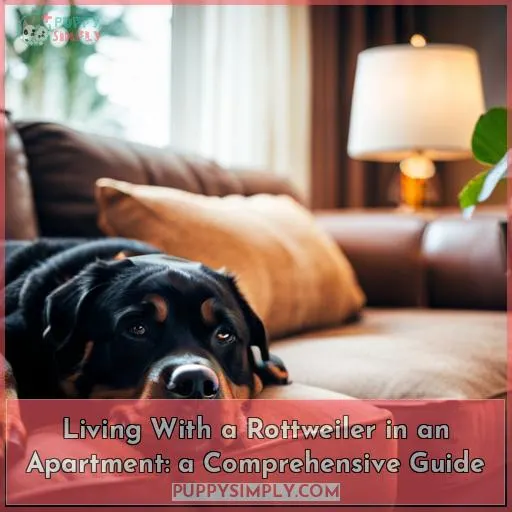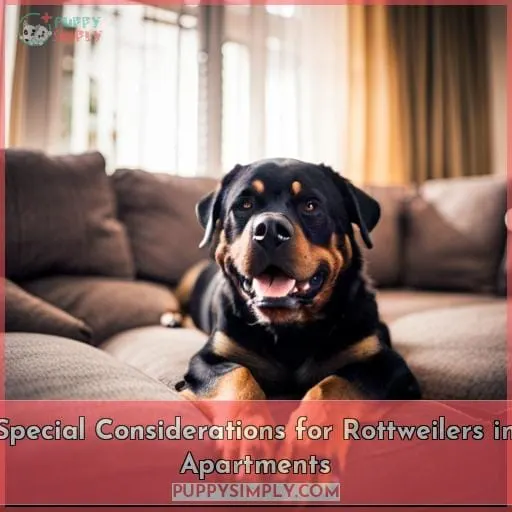This site is supported by our readers. We may earn a commission, at no cost to you, if you purchase through links.
 Living with a Rottweiler in an apartment can be like juggling plates on a unicycle – it’s possible, but it takes skill, dedication, and a lot of practice.
Living with a Rottweiler in an apartment can be like juggling plates on a unicycle – it’s possible, but it takes skill, dedication, and a lot of practice.
Rottweilers are loyal, intelligent, and protective dogs. They can make excellent companions for apartment dwellers, but they require a lot of exercise and attention.
If you’re thinking about getting a Rottweiler, it’s important to do your research and make sure you’re prepared to provide them with the care and attention they need.
This guide will provide you with everything you need to know about living with a Rottweiler in an apartment, from training and exercise to keeping them entertained.
Table Of Contents
- Key Takeaways
- Rottweilers in Apartments: Pros and Cons
- Puppies Vs. Adults: Which is Better for Apartment Living?
- Training Your Rottweiler for Apartment Life
- Exercise Needs: How Much is Enough?
- Keeping Your Rottweiler Happy and Healthy in an Apartment
- Special Considerations for Rottweilers in Apartments
- Choosing the Right Rottweiler for Apartment Living
- Tips for a Successful Rottweiler-Apartment Relationship
- Additional Information
- Frequently Asked Questions (FAQs)
- What are some common challenges that Rottweiler owners face when living in an apartment?
- How can I prevent my Rottweiler from becoming bored and destructive in an apartment setting?
- Are there specific health concerns that I should be aware of when keeping a Rottweiler in an apartment?
- What are some strategies for managing my Rottweiler’s barking and noise levels in an apartment building?
- How can I ensure that my Rottweiler gets enough socialization and interaction with other dogs while living in an apartment?
- Conclusion
Key Takeaways
- Rottweilers can thrive in apartments due to their companionship, less space requirements, and easy maintenance.
- Challenges include frequent bathroom trips, pent-up energy, potential for destructive behavior, and breed restrictions.
- Puppies may be more challenging in apartments due to frequent bathroom needs, boundless energy, and training requirements, while adult Rottweilers may be more adaptable.
- Successful apartment living requires consistent training, noise management, outdoor adventures, and engaging activities to keep the dog happy and healthy.
Rottweilers in Apartments: Pros and Cons
You’ll discover both advantages and disadvantages when sharing your apartment with a Rottweiler.
Advantages:
- Rottweilers thrive on companionship and prefer being close to their owners.
- Less space means less need to follow you around, reducing separation anxiety.
-
Owners are constantly close by, providing a sense of safety and comfort for the dog.
Disadvantages:
- Frequent bathroom trips may be necessary if there’s no grass access.
- Pent-up energy due to limited space can lead to destructive behavior.
- There’s also the risk of Parvovirus infection from unvaccinated dogs in shared spaces.
- Boredom can lead to destructive behavior and nuisance barking.
- Some apartment complexes have restrictions against Rottweilers.
Puppies Vs. Adults: Which is Better for Apartment Living?
When it comes to Rottweilers in apartments, you’ll face a decision: choosing between a puppy or an adult dog. Both have unique advantages and considerations that align with different lifestyles.
Adult Rottweilers are more adaptable to apartment living, often requiring less supervision and exhibiting calmer behavior. They’re generally past the puppy chewing and destructive stage, causing less damage to your apartment.
Training an adult Rottweiler can be easier, as they’ve a longer attention span and may already have some basic commands mastered.
Puppies, while undeniably adorable, come with their own set of challenges in an apartment. They require frequent bathroom breaks, which can be challenging if you don’t have easy access to outdoor space.
Their boundless energy may lead to destructive behavior if not properly exercised and entertained. Training a puppy takes patience and consistency, and you’ll need to invest time in housetraining and obedience classes.
Ultimately, the choice between a puppy and an adult Rottweiler depends on your lifestyle and preferences. Consider your available space, time for training and exercise, and your ability to handle the unique challenges of each stage.
Training Your Rottweiler for Apartment Life
To make your Rottweiler a great apartment companion, you’ll need to provide consistent training in several key areas.
Start with indoor enrichment to keep your dog occupied and mentally stimulated. Toys, puzzle feeders, and snuffle mats are excellent options.
Noise management is also crucial. Gradually expose your Rottweiler to common apartment noises, like doorbells, vacuum cleaners, and sirens.
Positive reinforcement training is key. Reward your dog for good behavior and use consistent commands. For example, establish a designated potty spot and use the same phrase each time you take your dog there.
Outdoor adventures are essential for physical and mental well-being. Aim for at least two daily walks, fetch games, and socialization.
By investing time and effort into training, you’ll create a harmonious and enjoyable living environment for your Rottweiler in your apartment.
Exercise Needs: How Much is Enough?
Provide at least an hour of exercise daily, including walks, runs, and playtime, to meet your Rottweiler’s exercise needs.
Ensure walks are brisk and cover a fair distance to provide both physical and mental stimulation.
Engage in interactive games like fetch or tug-of-war in a safe, open area.
Incorporate indoor activities like hide-and-seek or puzzle toys to stimulate your Rottweiler’s mind when outdoor exercise is limited.
Vary exercise routines to prevent boredom and keep your Rottweiler engaged. Try swimming, hiking, or agility training.
Adjust exercise intensity and duration based on your Rottweiler’s age and health.
Monitor your Rottweiler’s weight to ensure they maintain a healthy weight. Obesity can lead to health problems and hinder their ability to exercise.
Keeping Your Rottweiler Happy and Healthy in an Apartment
Creating a harmonious coexistence in an apartment for your Rottweiler means catering to their exercise needs, mental stimulation, and emotional well-being.
Beyond regular walks and playtime, introduce enrichment activities like puzzle feeders or interactive toys to engage their minds.
Consider indoor exercise options like treadmills or agility courses when outdoor space is limited.
To minimize disturbances, train your Rottweiler to respond to commands like quiet or settle down.
Maintain a consistent routine, providing structure and predictability.
Fortify your bond through positive reinforcement training techniques, fostering obedience and mutual respect.
| Aspect | Tips |
|---|---|
| Noise Management | Train your Rottweiler to respond to commands like quiet or settle down. |
| Neighbor Relations | Maintain a consistent routine, providing structure and predictability. |
| Training Techniques | Fortify your bond through positive reinforcement training techniques, fostering obedience and mutual respect. |
Special Considerations for Rottweilers in Apartments
Living with a Rottweiler in an apartment requires:
- Attention to noise constraints.
- Consideration for neighbors.
- Meeting exercise needs.
Training and creating a routine are essential for a happy and healthy dog.
Respecting landlord policies and local breed restrictions is crucial for a harmonious living environment.
Noise Constraints
You’ll also need to be mindful of noise constraints in your apartment building, since Rottweilers are known for their loud barking. To prevent noise complaints, consider:
Quiet Activities:
Engage your Rottweiler in calm, quiet activities like indoor games or puzzle toys.
Training Techniques:
Teach your dog basic commands like quiet or shush to control excessive barking.
Neighbor Relations:
Keep your neighbors in mind. Avoid letting your dog bark excessively, and apologize if it happens.
Neighbor Considerations
As a considerate dog owner, maintaining good relationships with your neighbors is essential for harmonious apartment living with your Rottweiler.
Showcasing courtesy and awareness of shared spaces is crucial to building community and avoiding conflicts.
Ensure your Rottweiler’s noise levels are kept to a minimum, respecting the tranquility of your neighbors.
Utilize proper training techniques to minimize excessive barking or disruptive behaviors that may disturb others.
By being mindful of your neighbors’ well-being, you can foster a positive and respectful living environment for all.
Neighbor Etiquette
- Be courteous and friendly
- Communicate openly
-
Show empathy and understanding
Noise Control
- Keep noise levels low
- Avoid disruptive behaviors
-
Utilize soundproofing measures
Shared Spaces Harmony
- Respect common areas
- Be mindful of others
- Build a sense of community
Exercise Needs
By creating a vigorous exercise routine, you’ll prevent boredom and destructive behaviors in your Rottweiler living in an apartment.
Prioritize daily walks, runs, or hikes to fulfill their physical needs.
Engage your Rottweiler’s mind with interactive toys, indoor enrichment activities, and mental stimulation games.
Seek out playdate opportunities at dog parks or arrange creative exercise sessions at home.
Space Requirements
To keep your Rottweiler happy and healthy in an apartment, you’ll need to provide adequate space for exercise and movement.
- Create a space-efficient layout that allows your Rottweiler to move around comfortably.
- Designate a specific indoor area for play and exercise, even if it’s just a corner of a room.
- Engage your Rottweiler in indoor activities like fetch, tug-of-war, or puzzle toys to stimulate their mind and body.
- Keep noise levels in check to avoid disturbing neighbors and ensure your Rottweiler feels safe and secure in your apartment.
Training Needs
Understanding your Rottweiler’s training requirements is crucial when living in an apartment.
Establish boundaries and expectations with consistent obedience commands, positive reinforcement, and clicker training.
Address potential behavioral challenges like separation anxiety, barking, and chewing through indoor enrichment activities, such as interactive toys and puzzle feeders.
Prioritize socialization with other dogs and people to ensure your Rottweiler is well-behaved in shared spaces.
| Training Technique | Benefit | Special Considerations |
|---|---|---|
| Positive Reinforcement | Encourages good behavior | Use treats, praise, and petting. |
| Clicker Training | Marks desired behavior | Pair the click with treats to create an association. |
| Obedience Commands | Ensures control | Start with basic commands like sit, stay, and come. |
| Indoor Enrichment | Prevents boredom | Rotate toys and activities to maintain interest. |
| Socialization | Promotes good behavior | Expose your Rottweiler to different people and animals. |
Choosing the Right Rottweiler for Apartment Living
When selecting a Rottweiler for apartment living, consider a dog’s age and energy level.
Puppies demand more attention and exercise, while adults are often calmer and better suited to smaller spaces.
Regardless of age, training and establishing a routine are crucial for a happy and well-behaved Rottweiler in an apartment.
Puppy vs Adult Suitability
When selecting a Rottweiler for apartment living, you’ll need to decide if a puppy or adult dog suits your lifestyle better.
Puppies require more attention, training, and frequent bathroom breaks.
Adult Rottweilers are typically calmer and better suited to smaller spaces.
Consider your time, energy, and training experience when making this decision.
Exercise and Routine
You’ll need to commit to a daily exercise routine, as Rottweilers require at least 60 minutes of physical activity.
Balance walks, runs, and playtime to keep your dog engaged. Vary routes and activities to prevent boredom.
Engage your Rottweiler mentally with interactive toys, puzzle feeders, and training sessions. Consider enrolling your dog in obedience classes or agility training for an extra challenge.
Outdoor adventures like hiking or swimming can be great bonding experiences.
Training and Behavior
For a successful Rottweiler-apartment relationship:
- Focus on consistent training and shaping their behavior.
- Establish clear rules and boundaries.
- Use positive reinforcement techniques.
-
Socialize your dog early on.
Behavioral Training:
-
Teach basic obedience commands and tricks to promote good behavior and control.
Socialization Techniques:
-
Expose your Rottweiler to different people, animals, and environments to help them become well-adjusted and comfortable in various situations.
Apartment Etiquette:
-
Train your Rottweiler to behave appropriately in the apartment, including not barking excessively, jumping on furniture, or destroying property.
Mental Stimulation:
- Provide interactive toys and games to keep your Rottweiler mentally stimulated and prevent boredom.
Tips for a Successful Rottweiler-Apartment Relationship
To ensure a harmonious relationship between your Rottweiler and your apartment:
- Establish a daily routine of exercise and playtime.
- Introduce your dog to new people and animals to promote socialization.
- Provide proper training to control unwanted behaviors.
Daily Routine and Exercise
Establishing a consistent routine with your Rottweiler not only ensures physical well-being but also maintains mental stimulation in the confinement of an apartment’s four walls.
Regular walks,
designated playtimes,
and engaging mental games
are essential pillars of a fulfilling routine, keeping your furry friend active, happy, and balanced amidst limited space.
Socialization
Along with regular exercise and proper training, socializing your Rottweiler from puppyhood ensures comfort and confidence around people and animals in your apartment complex.
Expose your Rottweiler to various outdoor environments, including parks, sidewalks, and dog-friendly stores.
Controlled canine interactions help them learn appropriate play and communication skills.
Teach them to overcome urban challenges like loud noises and heavy foot traffic.
Focus on public behavior, like heeling on a leash and ignoring distractions.
A well-socialized Rottweiler is a happy and well-adjusted apartment companion.
Proper Training
Train your Rottweiler to obey basic commands and exhibit good behavior in your apartment. This will ensure a harmonious living environment for both you and your pet.
Master Basic Commands:
- Start with commands like sit, stay, and come.
-
These provide a solid foundation for further training and control in various situations.
Positive Reinforcement:
- Use treats, praise, and petting as rewards for good behavior.
-
This positive reinforcement technique encourages your Rottweiler to repeat desired actions.
Indoor Etiquette:
-
Teach your Rottweiler proper indoor behavior, including:
- Not jumping on furniture
- Not begging at the table
- Not barking excessively
Additional Information
Now that you’re armed with the knowledge to ensure your Rottweiler’s happiness in an apartment, let’s delve into some insightful information.
Sloan McKinney, a renowned pet journalist, draws inspiration from her furry companions, DeAnthony the cat and Max the dog, to illuminate the path to pet ownership success. McKinney emphasizes the significance of responsible pet care, urging you to prioritize your pet’s well-being.
Recognizing breed traits is crucial in selecting the right dog for your lifestyle. McKinney encourages you to research specific breeds, considering their size, activity levels, and personality types. This informed decision-making process sets the stage for a harmonious coexistence between you and your canine friend.
Creating a happy and healthy life for your pet extends beyond providing basic necessities. McKinney advocates for a holistic approach, encompassing love, attention, training, and exercise. By fulfilling these fundamental needs, you’ll foster a strong bond with your pet, enriching both your lives.
Frequently Asked Questions (FAQs)
What are some common challenges that Rottweiler owners face when living in an apartment?
Apartment living with a Rottweiler can present challenges:
- Limited space for exercise
- Potential boredom leading to destructive behavior
- Risk of Parvovirus infection from unvaccinated dogs in shared areas
Careful planning, training, and routine can help you overcome these hurdles and provide your loyal companion with a happy home.
How can I prevent my Rottweiler from becoming bored and destructive in an apartment setting?
Keep your Rottweiler occupied with:
- Interactive toys
- Puzzle feeders
- Regular training sessions
Engage in daily exercise and socialization to fulfill its physical and mental needs, leaving it less prone to destructive behaviors.
Are there specific health concerns that I should be aware of when keeping a Rottweiler in an apartment?
Watch for signs of stress, anxiety, or depression in your Rottweiler, which can manifest in destructive behaviors or changes in appetite and sleep patterns.
Regular exercise and mental stimulation are key to maintaining your dog’s well-being in an apartment environment.
What are some strategies for managing my Rottweiler’s barking and noise levels in an apartment building?
Train your Rottweiler early to minimize barking and noise.
Establish commands for silence and reward quiet behavior.
Consider soundproofing your apartment or using noise-canceling curtains to reduce disturbances for neighbors.
How can I ensure that my Rottweiler gets enough socialization and interaction with other dogs while living in an apartment?
Engage your Rottweiler in socialization activities to fulfill its social needs and prevent loneliness:
- Dog park visits
- Group training classes
- Playdates
Conclusion
Living with a Rottweiler in an apartment is like juggling flaming torches while balancing on a tightrope.
But with the right approach, it’s a rewarding experience.
It’s crucial to provide ample exercise, training, and mental stimulation to keep your Rottweiler happy, healthy, and well-behaved in your apartment.
So, if you’re up for the challenge, embrace the journey of living with a Rottweiler in an apartment.
Just remember, it’s not for the faint of heart, but it’s a journey worth taking.















